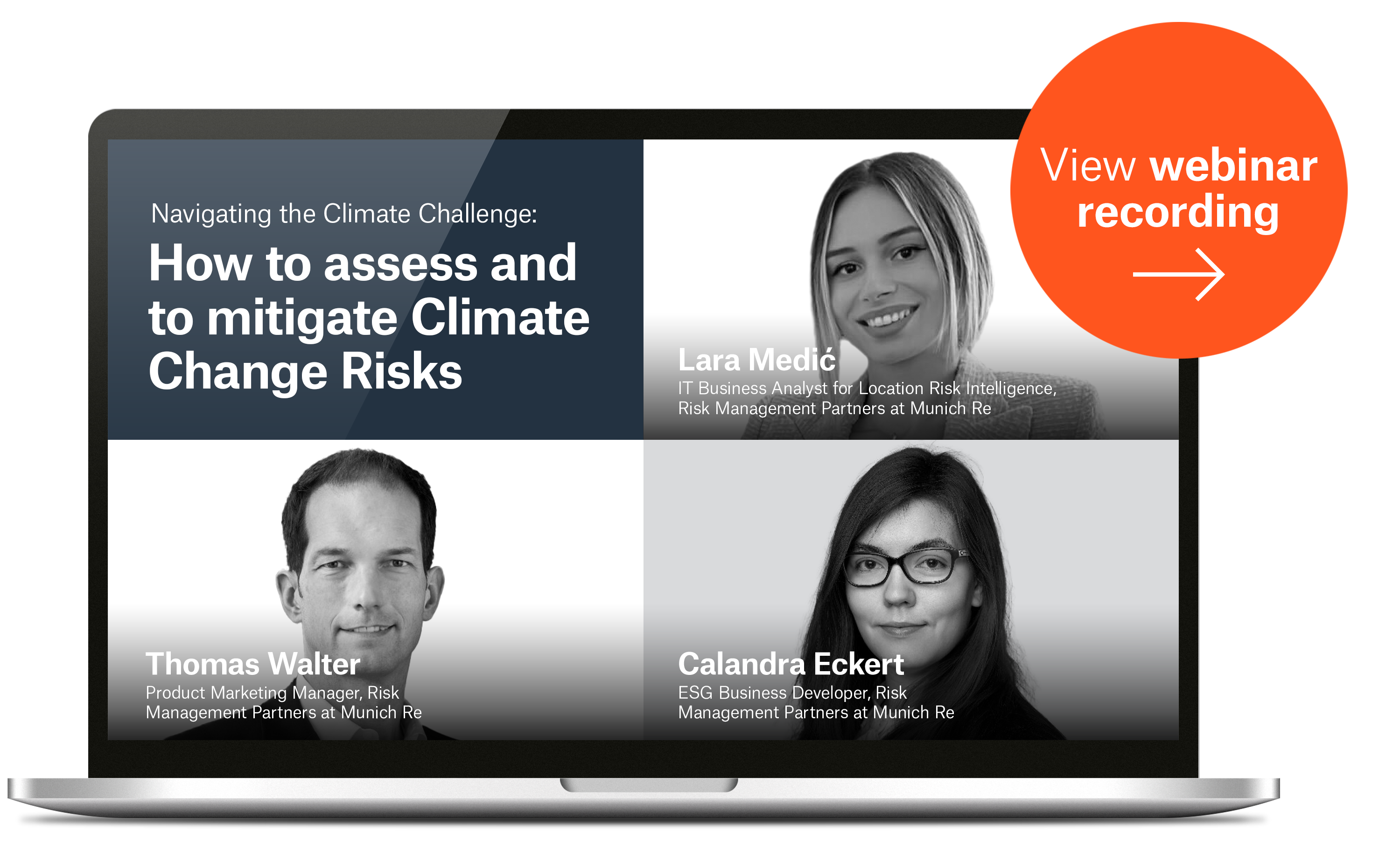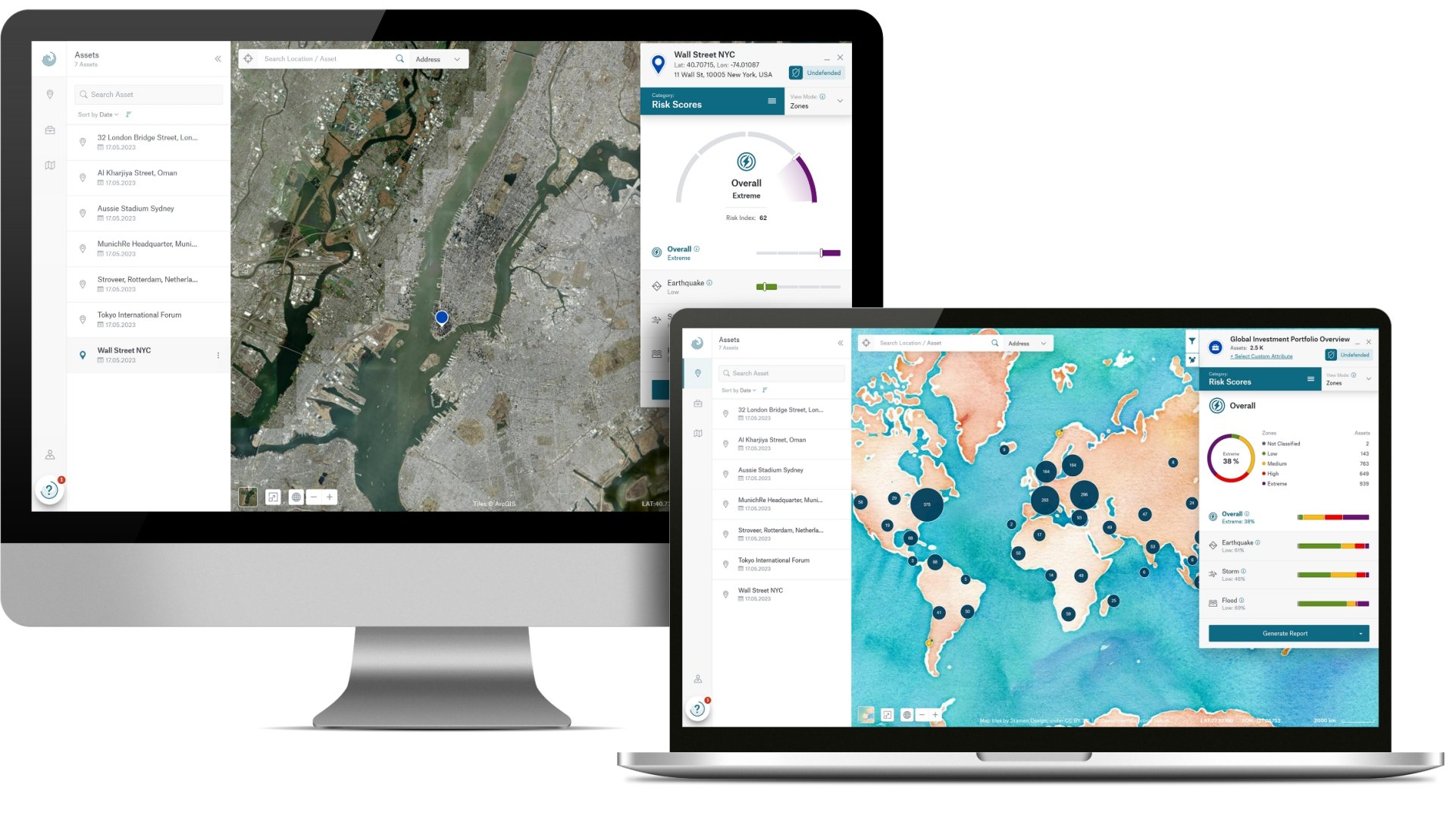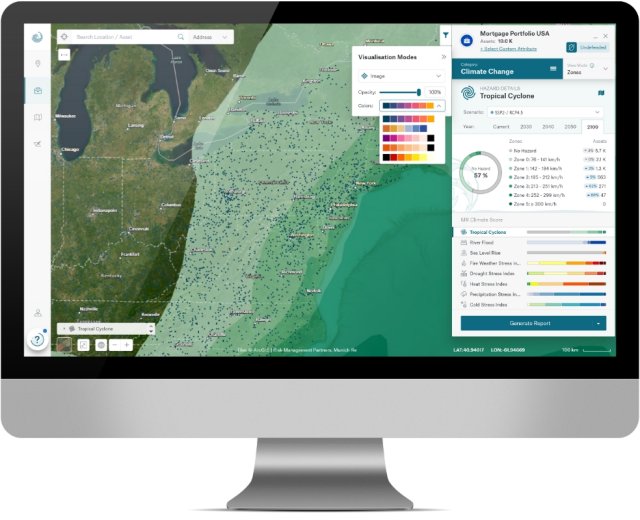
Munich Re’s
Location Risk Intelligence
Master the physical risks caused by natural hazards and climate change
properties.trackTitle
properties.trackSubtitle
Extreme weather is the No. 1 of all risks for business leaders around the world.
Even in the long-term perspective of the next decade, extreme weather ranks first among the top 10 risks, five of which are environmental or climate-related.
Webinar recording: Navigating the Climate Challenge:
How to assess and to mitigate Climate Change Risks

Master your risks with the easy-to-use analysis tool for advanced decision-making

With the help of Munich Re’s climate risk data we are well-prepared for heightened reporting requirements, such as Pillar 3 disclosure.
It’s a further fact that the effects of climate change will have a much greater impact on the future of your business. Are you ready?
It’s time to reduce your risks! Book your live demo right now
Gain a competitive edge by factoring climate risk into your business decisions …

- Increase profitability and improve top and bottom-line results
- Stay competitive by incorporating risk in advance and adapting your offerings accordingly
- Avoid losses and safeguard your business
- Avoid bad assets in your portfolio all around the globe
- Meet your stakeholder requirements by responding with confidence based on sound climate risk insights and analytics
- Be well prepared for reporting. Right out-of-the-box and with customisable reporting capabilities
- Reduce time and effort. Location Risk Intelligence combines data visualisation, evaluation and reporting in a single tool
- Stop the guesswork. Base your decisions on reliable data and benefit from a globally leading climate data provider
- Improve decision-making and become an expert - based on reliable and trustworthy data, using the latest scientific standards
Our comprehensive solution enables you to manage all your climate risks in a highly professional way – and in just one place
Four risk editions - choose the one that suits you best
Natural Hazards Edition
Wildfire HD Edition
Climate Change Edition*
This edition will help you not only to understand your exposure to current physical risks, but more importantly to analyse and assess the physical risks associated with climate change in different future scenarios. Considering both acute and chronic climate risks, this edition provides information on seven climate hazard scores. And unlike the Natural Hazards Edition, the risk scores are not only calculated based on past events, but also include projected changes in the intensity and frequency of future events under different climate scenarios.
*Also available as an On-Demand version for analysing single assets
Pay as you go: in the On-Demand version, users without a contractual commitment can use credits that can be purchased directly on the website to determine risk assessments for single locations (not entire portfolios) and download them in meaningful reports.
Climate Financial Impact Edition
Get it all. For further information simply download our “Location Risk Intelligence” brochure!
High value platform functionalities
Single asset assessment
Using asset assessment you can search for individual locations and quickly identify how exposed they are to current as well as future hazards, and what their exposure implies in terms of risk.
Finding locations is easy, either by entering coordinates, an address or just selecting a location on the map. As a search result you receive two types of scores: Firstly, a risk score in which individual risk assessments are grouped for the purpose of directly identifying red flags, and secondly, hazard zones with detailed asset score representation for the kind of in-depth analysis that enables risk-aware decision-making.
This continuous risk monitoring process is supported by smart features with which you can save your scored locations as assets, and then fully manage them in the asset panel list or move individual assets to portfolios.Using asset assessment you can search for individual locations and quickly identify how exposed they are to current as well as future hazards, and what their exposure implies in terms of risk.
Finding locations is easy, either by entering coordinates, an address or just selecting a location on the map. As a search result you receive two types of scores: Firstly, a risk score in which individual risk assessments are grouped for the purpose of directly identifying red flags, and secondly, hazard zones with detailed asset score representation for the kind of in-depth analysis that enables risk-aware decision-making.
This continuous risk monitoring process is supported by smart features with which you can save your scored locations as assets, and then fully manage them in the asset panel list or move individual assets to portfolios.
Portfolio assessment
If you are responsible for entire asset portfolios (such as real estate or production sites), you will need an extended risk view across your entire portfolios.
Assess climate risk for portfolios with multi-million sites in a single operation.
The traffic light visualisation enables you to easily review the risk distribution of your portfolio and to identify red flags. You can dive deeper by examining the exposure of your portfolio, or subsets of it, to each individual hazard. Reports from your portfolio assessments can be downloaded in the format of your choice.
Managing your portfolio assessments is convenient and time-saving: Upload your portfolio by drag-and-drop using standard formats such as Excel or CSV, and then store it in your portfolio panel for future use. If your portfolio changes, you can add or delete assets, or rename your entire portfolio.
Portfolio management
Managing portfolios is a complex task. To help you manage these successfully, we provide you with a complete toolset including portfolio filtering, visualisation and sharing. While portfolio filtering helps you understand the risk in a subset of your portfolio, portfolio visualisation allows you to view the locations of your portfolio on a digital world map. This is supported by a variety of settings, such as different background maps, opacity adjustments or colour changes, which you can use for the ideal visual representation of the insights you gain from the risk analysis.
You can also improve collaboration with selected colleagues or your entire organisation by sharing uploaded and scored portfolios with a simple click of your mouse.
Export manager
By exporting your climate risk data, you can meet the growing demand for greater transparency and share your data with all relevant stakeholders. To enable them to use your data in other applications, you can export the results of your analysis as a CSV or Excel file, or as a comprehensive report in PDF format.
In addition, the export manager allows you not only to customise your reports by making specific selections from all the data available, but also to save them as export templates for repeated use, ensuring their consistent application across your organisation.
Maps
Understanding risk is mission-critical and requires the best possible representation of the results. This is where our wide range of available maps comes in and makes the difference. They are an integral part of the Location Risk Intelligence Platform and allow you to visualise each hazard value in the best possible way.
For example, you can change your base map, completely rearrange maps, increase or decrease opacity, or select the desired map directly from the score panel in order to visualise your results clearly and without the risk of any misinterpretation.
Customer Success and support hotline
Ensure satisfied users and accurate results from day one with an intuitive user interface and user-specific in-app guidance.
When using the platform for the first time, or if you need assistance, the built-in wizard guides you through the platform's features and common use cases with interactive, step-by-step instructions which help you to get up and running quickly.
The connected support centre helps you find answers to the most frequently asked questions, as well as technical explanations and advice. This area also enables users to report bugs or other issues, as well as to find all the legal information about the platform.
The profile section not only contains all your account details and password settings, but also provides an up-to-date overview of your data usage.
Elevation profile
Portfolio aggregation and comparison
Uncover the risk exposure of your assets in detail by aggregating portfolios and comparing them with each other or with a subset. This adds an additional perspective to your portfolio management in a wider context.
By aggregating portfolios or expanding existing ones, you can keep a constant eye on the physical risks threatening your portfolio, even as new assets are added.
The portfolio comparison puts context into your portfolio management as you can benchmark the risk exposure of a portfolio or its subset with another portfolio. This can also be done with aggregated portfolios.
Areas & Lines
Business data is not always ideally represented by an address or coordinate. For example, railway lines, roads, airports, industrial plants, renewable energy parks and ecological areas require specific risk scoring capabilities that extend asset characteristics from single points to user-drawn areas & lines and predefined geometries.
Area & line scoring capabilities show the percentage of an area exposed to a particular natural hazard and provide relevant risk insights for such areas.
To conduct risk assessments at a broader regional level, you can choose from a wide range of prescored areas, including aggregated assessments for countries, administrative zones, postcodes, NUTS zones, or CRESTA zones and more.
REST API
Single Sign-On
Single Sign-On is a simple way to increase both cyber security and the efficiency of your operations, in that to access different software applications with the highest possible level of security your employees only need to sign in once with one set of credentials, rather than multiple times.
Because your employees only need to remember one username and password, you also reduce the risk of data leaks due to weak or re-used passwords, as well as the work involved in managing user accounts. And, by the way, you also enhance user satisfaction through significantly increased user-friendliness.
Quick implementation – get started within 2 days!
Location Risk Intelligence can be implemented in the shortest possible time to help you assess and manage your risks. Contact us and let’s get started.



